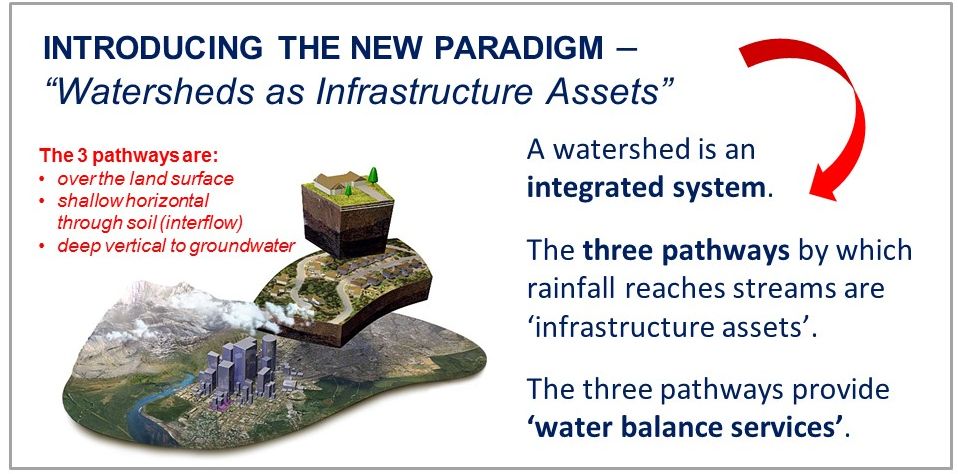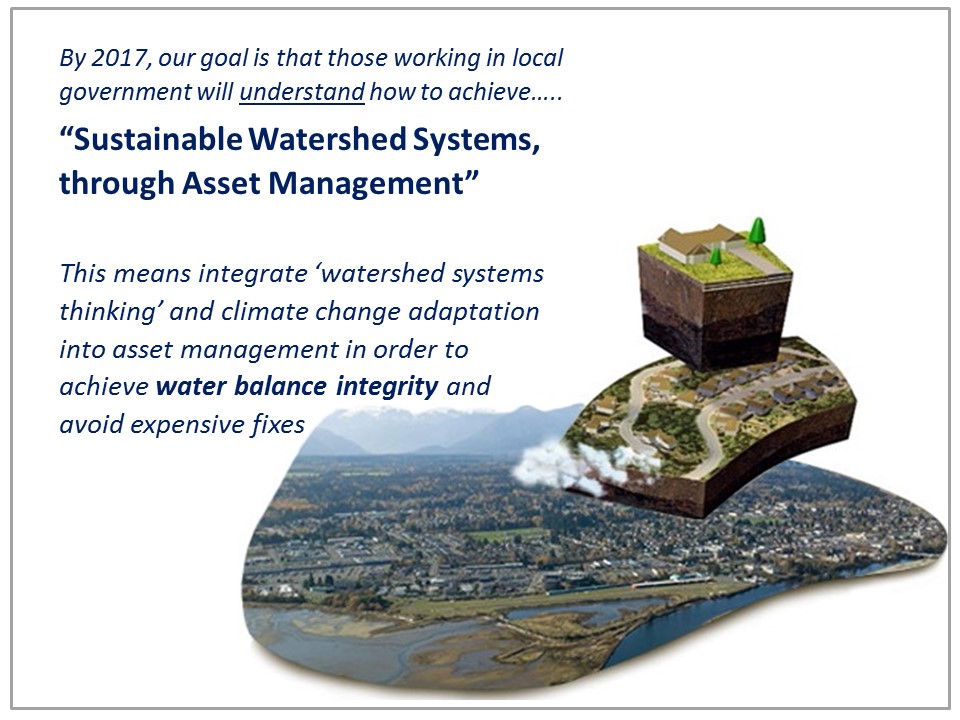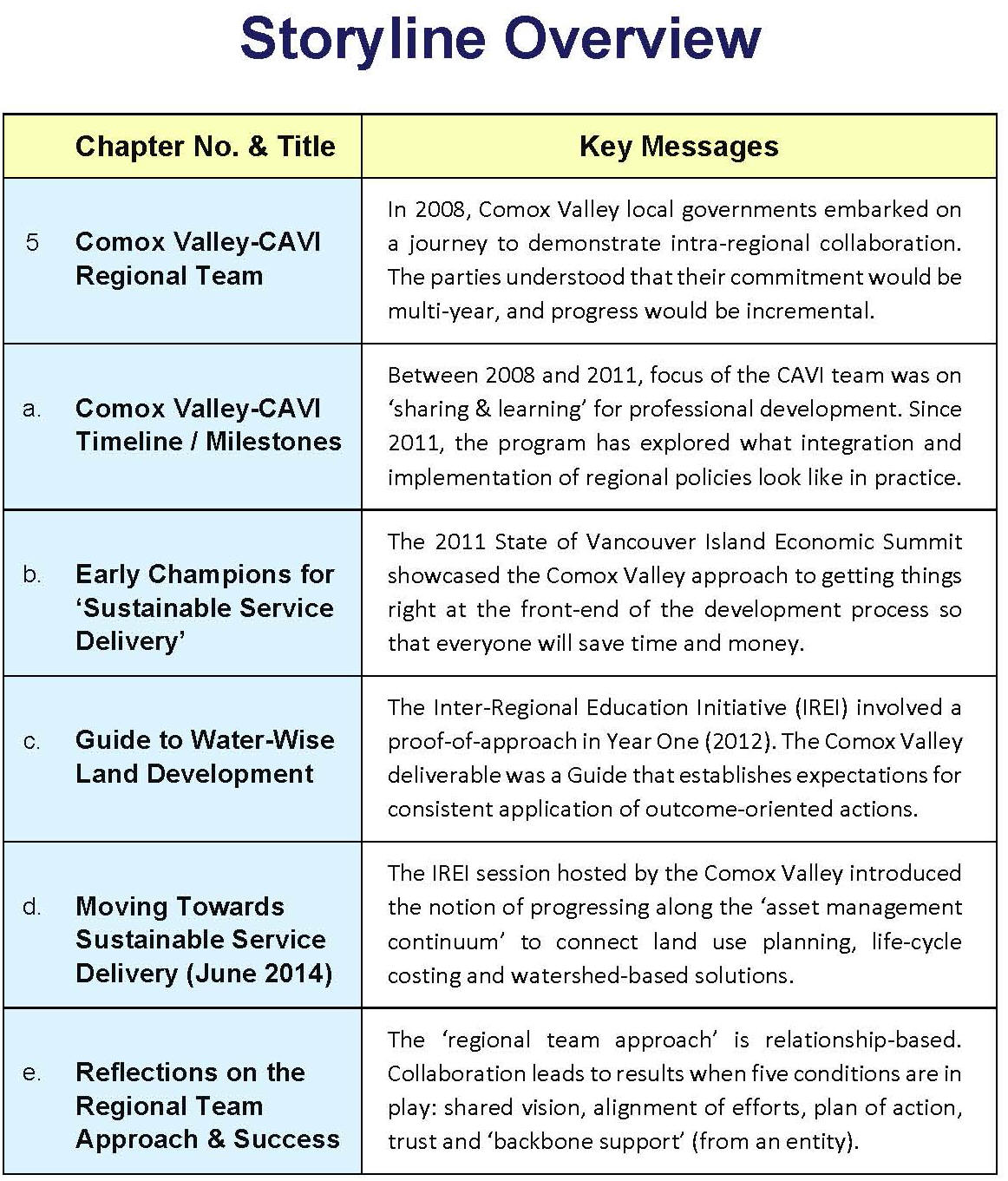"Beyond the Guidebook 2015" introduced to Comox Valley Regional Board (Nov 2015)
Note to Reader:
Five regional districts representing 75% of the population of BC are partners in the Georgia Basin Inter-Regional Educational Initiative (IREI). The Capital Regional District (CRD) is one of the five. Led by the Partnership for Water Sustainability in BC, the over-arching goal of the IREI is to provide tools to help organizations achieve their water sustainability goals.
A program deliverable is Beyond the Guidebook 2015: Moving Towards “Sustainable Watershed Systems, through Asset Management”, released in November 2015. Following release of this guidance document, Kim Stephens (Executive Director, Partnership for Water Sustainability in BC) met with each of the partners to celebrate their contribution to Beyond the Guidebook 2015. He met with the Comox Valley Regional District Committee-of-the-Whole on November 10, 2016.
Comox Valley – Early Champions for ‘Sustainable Service Delivery’
“The meeting with the Comox Valley Regional Board was the opportunity to introduce them to a new way of thinking about drainage and water use,” stated Kim Stephens in describing the purpose of his presentation in rolling out Beyond the Guidebook 2015.
 “It provided to be timely that I followed an update presentation by a BC Hydro representative (Stephen Watson). He commented on how the natural water balance is changing. It is feast and famine because the annual precipitation in 2015 is consistent with long-term annual averages, but the distribution is different.”
“It provided to be timely that I followed an update presentation by a BC Hydro representative (Stephen Watson). He commented on how the natural water balance is changing. It is feast and famine because the annual precipitation in 2015 is consistent with long-term annual averages, but the distribution is different.”
To Learn More:
Download Beyond the Guidebook 2015: Presentation to the Comox Valley Regional Board in November 2015 to view the complete storyline for the presentation by Kim Stephens.
Sustainable Watershed Systems
“Stephen’s observations provided me with a springboard to talk about the concept that the Partnership for Water Sustainability is branding as Sustainable Watershed Systems. We are urging the local governments to look beyond the techno-babble and view watersheds as integrated systems.”
“Watershed protection starts with an understanding of how the rain that falls on the landscape reaches streams by one of three pathways – overland, vertically to deep groundwater, and laterally through the shallow soil zone as interflow.”
Water Balance Integrity
“The 2015 drought provided the backdrop for my presentation because it was fresh on the Board’s mind, especially after they heard from Stephen Watson above the inflows to Comox Lake,” continued Kim Stephens. “After connecting the dots to the 2003 ‘teachable year’ when we last had a provincial drought with a comparable impact, I explained how it had taken more than a decade to move from the ‘teachable year’ to an implementation framework for water-resilient communities.”
“In 2014, three landmark initiatives came to fruition: the new Water Sustainability Act plus regulatory documents, namely: Develop with Care 2014, and Asset Management for Sustainable Service Delivery: A Framework for BC. Together, they provide a framework for integrated actions to achieve water balance integrity and avoid expensive fixes. They are game-changers, I emphasized.”
A Framework for BC
“The BC Framework for sustainable service delivery is the lynch-pin. It is strategically aligned with asset management requirements under senior government funding programs,” stated Kim Stephens. “This provides additional incentive for implementing holistic asset management practices, including integration of watershed systems thinking and natural capital into asset management.”
“This was my opportunity to inform the Board that the Comox Valley was an early adopter of the vision. This dates back to 2011 when the annual Learning Lunch Seminar Series foreshadowed the future requirement to view watersheds and watershed health through an asset management lens. I observed that it is not coincidence that the current CAO with the City of Courtenay is a champion. I referred them to an article that I had co-authored with David Allen.”
To Learn More:
Download and read Sustainable Watershed Systems, an article co-authored by Kim Stephens, Emanual Machado and David Allen, and published in the September-October 2015 issue of Construction Business magazine.
Convening for Action in the Comox Valley
In June 2008, Comox Valley local governments volunteered to be a ‘demonstration application’ for exploration of a regional team approach that would be guided by the Living Water Smart target for watershed health. And so the CAVI-Comox Valley Regional Team was formed and embarked on a journey together.
To Learn More:
The Comox Valley chapter in Beyond the Guidebook 2015 is 12 pages and is organized in six sections as shown below. To download a PDF copy and read the complete story, click on Comox Valley-CAVI Regional Team.
To download a copy of the entire 158-page Beyond the Guidebook 2015: https://waterbucket.ca/viw/files/2015/11/Beyond-Guidebook-2015_final_Nov.pdf






